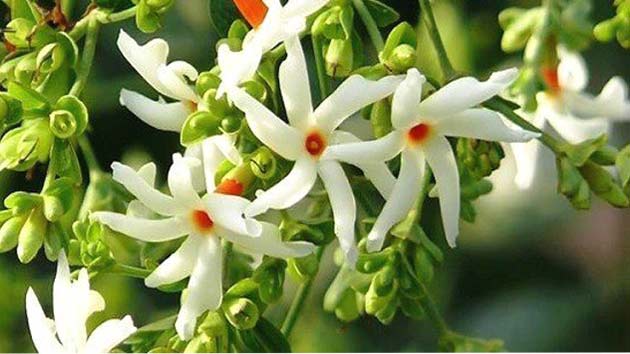Harsingar plant is also called Night Jasmine or even Parijat (Kalp tree). It is full of beneficial abilities and is commonly seen in South Asia. It’s a small tree or a shrub growing up to 33 feet tall with flaky grey bark. The leaves are quite broad with a margin. The plants appear beautiful with 5 to 8 white corolla flowers, the middle of which is orange-red. The fruit that this flower conveys is a brownish round to heart-shaped capsule of 2 cm diameter containing a single seed. This plant is found in large numbers in West Bengal, India. Also, in the region of Kanchanaburi in Thailand. This flower loses its brightness during daytime and is most commonly employed as a yellow dye for clothing.
Parijat (Nyctanthus arbortristis linn.) Commonly known as Night Jasmine, a fantastic plant is explained in Ayurveda using its enormous medicinal value. It is largely located in sub-tropical Himalayas of Nepal and southern areas of India and widely cultivated in tropical and subtropical regions all over the world. It is widely identified as harsingar rather than Parijat.
What are the Benefits of Harsingar Plant?
The blossoms are very beneficial as it includes essential oils and glycosides. The bark of the plant is useful as a result of its alkaloids and glycosides content. The consequences of the flower possess antifungal and antibacterial properties. In addition to this, some harsingar plant benefits are stated below.
- Provides relief from chikungunya and dengue
- Can treat arthritis
- Cures malaria and other fevers
- Prevents radical harm to the entire body
- Anti-allergic, antiviral and antibacterial properties
- Can treat cough
- Combats breathing issues
- Acts as a laxative
- Prevents gas
The leaves of Harsingar plant comprises some necessary chemicals that are very beneficial and important for the human body. For instance-benzoic acid, fructose, glucose, carotene, amorphous resin, oleic acid, methyl salicylate, tannic acid, oleanolic acid and flavonol glycosides.
Also read: Moringa Plant: Complete Medicinal plant Guide
Medicinal use of Harsingar Plant
Various sections of this flower are being used for different medicinal purposes. The leaves of harsingar plant medicinal use, for example as an anti-bacterial, anti-inflammatory, antipyretic and anti-helminthic effect. Information of environment, anatomy, etymology, current pharmacology, medicinal applications, etc. Are richly found in ayurvedic literature.
- Its leaves are Saline in flavor which gives significant relief from the diagnosis of different forms of fever or inflammation such as measles, excessive temperature, severe cough and cold.
- It offers an effective cure for different diseases of the body, varying from severe cold and cough to inflammation and sciatica
- The juices of its leaves, when combined with some sugar is a safe remedy for managing children’s gastrointestinal disorders.
- Parijat is often used for making various ‘facial packs,’ since it creates a shimmery glow to the face and offers a promised cure for a range of skin disorders.
- Seeds of the Parijat flower are used for the therapy of skin diseases and indigestion.
- This plant is suitable for coloring as well. Flowers can be used as a source of yellow dye for textile purposes. They are also used to produce cologne because of its rich fragrance.
- The dry flowers and fried fresh leaves are used in many Assamese food recipes.
- The flowers are blood thinner, anti-oxidant, anti-inflammatory and painkiller.
- Floral oil may be used quite commonly as a perfume.
Use of Harsingar Leaves for The Treatment of some harmful diseases
- Treatment is available with the juice of Harsingar leaves for sciatica and it is commonly used in the ayurvedic medicine method for the diagnosis of sciatica, inflammation, fatigue, and other painful disorders as well.
- The Harsingar Seeds are used to treat an assortment of skin diseases. The flowers are utilized to create different face packs for skin breakouts. The blossoms give the skin a glistening glow and reduce acne.
My people use leaves of harsingar for diabetes and it is also known to be utilized in lowering glucose levels. Studies indicate that flower extracts of Harsingar have a potent anti-diabetic effect. Due to the lack of individual studies, it’s better to request your Ayurveda doctor for comprehending the Anti-diabetic effects of Harsingar.
How to Care Harsingar Plant?
If question “How to grow Harsingar Plant” is popping out in your mind then you just follow these steps for harsingar plant care:
- Its most significant danger of this plant is stagnant water, which allows the roots to decay and to die. Periodic daily watering, well-broken composting and liberal trimming is ideal for this flower and is sufficient to enable it to grow and make your garden beautiful and fragrance.
- The fertilization of plants after one year would be helpful. The plant has to be clipped because the shoots expand in separate directions. It’s easier to cultivate the plant from the shaded section of the greenhouse, which gets a few hours of direct sunshine.
FAQs:
Q1. How to propagate Harsingar plants?
- Step1– Cut away a section of stem. To make your cuttings, pick healthier growth that’s 3 to 6 inches long.
- Step2– Remove the lower leaves. Cutaway the leaf on the bottom half of the plant so that you have a flat stem to go through the potting mix.
- Step3– Pot up your cutting.
Q2: How to graft a Harsingar plant?
Make the cuttings about 6 inches (15cm), and cut each one directly under a leaf. Strip the leaves in the bottom part of the cutting and dip it in rooting hormone powder. Put each cutting into a pit in moist sand at a planter, and place the planter in a plastic bag to hold moisture.
Q3: How do Harsingar leaves cure arthritis?
For Osteoarthritis, take 5-6 leaves. Crush and, put them in a glass of water, and boil until it’s half. Drink in the daytime as first thing along with eating the boiled leaves

